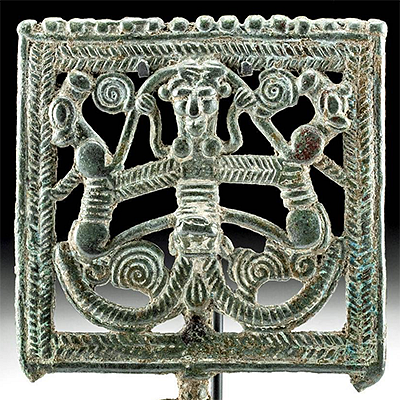Moche Pottery Stirrup Vessel with Jaguar Hunting Scene
Lot 69c
About Seller
Artemis Gallery
686 S Taylor Ave, Ste 106
Louisville, CO 80027
United States
Selling antiquities, ancient and ethnographic art online since 1993, Artemis Gallery specializes in Classical Antiquities (Egyptian, Greek, Roman, Near Eastern), Asian, Pre-Columbian, African / Tribal / Oceanographic art. Our extensive inventory includes pottery, stone, metal, wood, glass and textil...Read more
Estimate:
$1,200 - $1,800
Absentee vs Live bid
Two ways to bid:
- Leave a max absentee bid and the platform will bid on your behalf up to your maximum bid during the live auction.
- Bid live during the auction and your bids will be submitted real-time to the auctioneer.
Bid Increments
| Price | Bid Increment |
|---|---|
| $0 | $25 |
| $300 | $50 |
| $1,000 | $100 |
| $2,000 | $250 |
| $5,000 | $500 |
| $10,000 | $1,000 |
| $20,000 | $2,500 |
| $50,000 | $5,000 |
| $100,000 | $10,000 |
| $200,000 | $20,000 |
About Auction
By Artemis Gallery
Nov 5, 2020
Set Reminder
2020-11-05 10:00:00
2020-11-05 10:00:00
America/New_York
Bidsquare
Bidsquare : Ancient & Ethnographic From Around the World
https://www.bidsquare.com/auctions/artemis-gallery/ancient-ethnographic-from-around-the-world-5916
Ancient art from Egypt, Greece, Italy and the Near East, as well as Asian, Pre-Columbian, Native American, African / Tribal / Oceanic, Spanish Colonial, Russian Icons, Fine art, much more! All categories, all price ranges... all legally acquired and guaranteed to be as described or your money back. Artemis Gallery info@artemisgallery.com
Ancient art from Egypt, Greece, Italy and the Near East, as well as Asian, Pre-Columbian, Native American, African / Tribal / Oceanic, Spanish Colonial, Russian Icons, Fine art, much more! All categories, all price ranges... all legally acquired and guaranteed to be as described or your money back. Artemis Gallery info@artemisgallery.com
- Lot Description
Pre-Columbian, North Coast Peru, Moche, Phase III, ca. 350 to 550 CE. A mold-formed, highly burnished pottery stirrup vessel presenting with a circular base, cylindrical body, flat top, and two tubular necks that join together at a slender centrically located spout. The circumference of the glistening taupe-hued exterior presents two nearly identical high relief hunting scenes, each featuring a man dressed in a loin cloth, rectangular headdress, and circular earspools standing as he holds a long weapon in his right hand and the tail of a jaguar in the other. His sizable head, featuring heavy lidded almond-shaped eyes, a bulbous nose, a pointed chin, and pursed lips, is turned in profile as he focuses on his bounty; a jaguar who, none too pleased with the matter at hand, bends both legs in an effort to scurry away and twists his head back, showing his long sharp teeth to his oppressor, perhaps even letting out a fierce growl. The action-packed narrative is flanked by two incised lines, creating two ribbon-like borders along the base and top of the vessel. An engaging example from the Moche! Size: 5.25" W x 9.75" H (13.3 cm x 24.8 cm)
The jaguar symbolized power and might throughout the Pre-Columbian world. Warriors, rulers, hunters, and shamans alike associated themselves with this king of beasts, the largest and most powerful feline in the New World. The principal Moche god wears a headdress adorned with a jaguar head and paws and important mortals donned similar headdresses. A nocturnal animal, the jaguar sleeps in caves and dark places and creeps quietly in the forest, evoking great mystery. Oddly enough, few Moche artists would have actually seen jaguars as they are not indigenous to the coast. Jaguars prefer moist forest conditions. However, scholars believe that some cubs were transported over the mountains for Moche rituals, and it is also possible that some jaguars wandered down the coast.
Provenance: private southwestern Pennsylvania, USA collection, acquired prior to 2000
All items legal to buy/sell under U.S. Statute covering cultural patrimony Code 2600, CHAPTER 14, and are guaranteed to be as described or your money back.
A Certificate of Authenticity will accompany all winning bids.
We ship worldwide and handle all shipping in-house for your convenience.
#160178Light surface wear with minor nicks/chips, scratches, and abraded areas throughout. Barely distinguishable number written in pencil on base. Otherwise, excellent and intact with superb remaining pigments and nice earthen deposits in recessed areas.Condition
- Shipping Info
-
All shipping is handled in-house for your convenience. Your invoice from Artemis Gallery will include shipping calculation instructions. If in doubt, please inquire BEFORE bidding for estimated shipping costs for individual items.
-
- Buyer's Premium



 EUR
EUR CAD
CAD AUD
AUD GBP
GBP MXN
MXN HKD
HKD CNY
CNY MYR
MYR SEK
SEK SGD
SGD CHF
CHF THB
THB
















